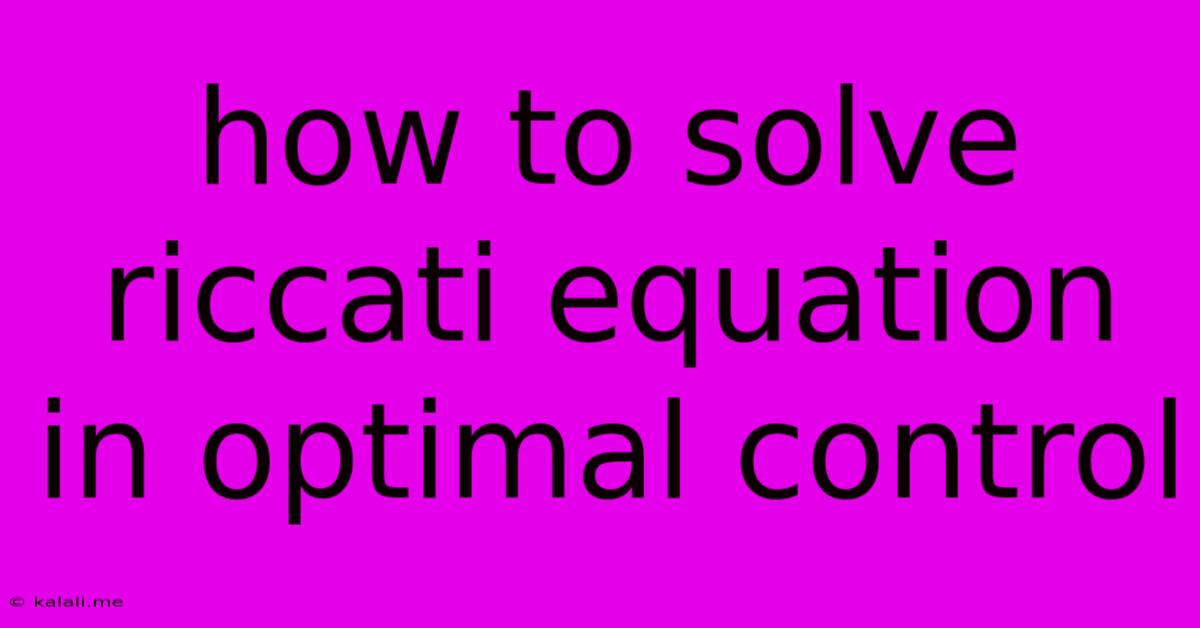How To Solve Riccati Equation In Optimal Control
Kalali
Jun 04, 2025 · 3 min read

Table of Contents
Solving Riccati Equations in Optimal Control: A Comprehensive Guide
Optimal control problems often involve solving the Riccati equation, a nonlinear matrix differential equation. Understanding how to solve it is crucial for finding optimal control strategies in various applications, from aerospace engineering to economics. This article provides a comprehensive guide to tackling Riccati equations within the context of optimal control, covering both analytical and numerical approaches.
This article will explore different methods for solving the Riccati equation, crucial for determining optimal control laws in linear-quadratic regulator (LQR) problems. We'll examine both continuous-time and discrete-time formulations and discuss their applications in control system design.
Understanding the Riccati Equation in Optimal Control
The Riccati equation arises when solving optimal control problems using dynamic programming or the maximum principle, particularly in linear systems with quadratic cost functions (LQR problems). The general form of the continuous-time Riccati equation is:
A'P + PA - PBR⁻¹B'P + Q = 0
where:
- P: The solution (a symmetric positive semi-definite matrix), representing the optimal cost-to-go.
- A: The system dynamics matrix.
- B: The control input matrix.
- Q: The state cost matrix (positive semi-definite).
- R: The control cost matrix (positive definite).
- ' denotes the transpose.
The discrete-time Riccati equation is:
Pₖ₊₁ = A'PₖA - A'PₖB(R + B'PₖB)⁻¹B'PₖA + Q
where:
- Pₖ: The solution at time step k.
- Other variables retain their meaning from the continuous-time equation.
The solution to the Riccati equation is essential because it directly yields the optimal feedback control law:
u* = -R⁻¹B'Px
where u* is the optimal control input and x is the state vector.
Methods for Solving the Riccati Equation
Solving the Riccati equation can be challenging due to its nonlinearity. Several approaches exist, each with its strengths and weaknesses:
1. Analytical Solutions:
Analytical solutions are possible only for specific, simplified cases. These often involve low-dimensional systems or special structures of the matrices A, B, Q, and R. Finding an analytical solution usually requires advanced linear algebra techniques.
2. Numerical Methods:
For most real-world problems, numerical methods are necessary. Popular techniques include:
-
Iterative methods: These methods start with an initial guess for P and iteratively refine it until convergence is achieved. Examples include the Kleinman algorithm (for continuous-time) and iterative solutions based on the discrete-time equation. Convergence is not guaranteed for all cases.
-
Matrix factorization techniques: These methods leverage the properties of the Riccati equation to decompose the matrices involved, making the solution more efficient.
3. Software Packages:
Numerous software packages provide built-in functions for solving Riccati equations. These packages often utilize sophisticated numerical algorithms, ensuring accuracy and efficiency. MATLAB's care (continuous-time algebraic Riccati equation) and dare (discrete-time algebraic Riccati equation) functions are prime examples.
Applications and Considerations
The Riccati equation finds wide applications in various fields, including:
- Linear Quadratic Regulator (LQR) Design: The cornerstone of LQR controllers.
- Kalman Filtering: Used in the design of optimal state estimators.
- H∞ Control: Extends LQR concepts to robust control design.
- Game Theory: Solving certain dynamic games with quadratic costs.
When working with Riccati equations, it's crucial to:
- Choose appropriate numerical methods: Selecting the right method depends on the problem's complexity and desired accuracy.
- Handle numerical stability: Numerical errors can accumulate during iterations, leading to inaccurate solutions. Employing robust numerical techniques is crucial.
- Verify the solution: After obtaining a solution, check its properties (e.g., positive semi-definiteness of P) to ensure validity.
Conclusion
Solving the Riccati equation is fundamental to optimal control theory. While analytical solutions are limited, various numerical methods and software packages provide reliable solutions for complex problems. A thorough understanding of these techniques, along with careful consideration of numerical stability, is crucial for successful application in control system design and other relevant fields. By mastering the solution methods for the Riccati equation, engineers and researchers gain valuable tools for designing high-performance control systems.
Latest Posts
Latest Posts
-
Connect Sposervice No Valid Oauth 2 0 Authentication Session Exists
Jun 06, 2025
-
Is There Work Done By The Lorentz Force
Jun 06, 2025
-
Standard Height Closet Shelf And Rod
Jun 06, 2025
-
What Insulation Do I Use In Showers
Jun 06, 2025
-
What Blood Type Does Jesus Have
Jun 06, 2025
Related Post
Thank you for visiting our website which covers about How To Solve Riccati Equation In Optimal Control . We hope the information provided has been useful to you. Feel free to contact us if you have any questions or need further assistance. See you next time and don't miss to bookmark.